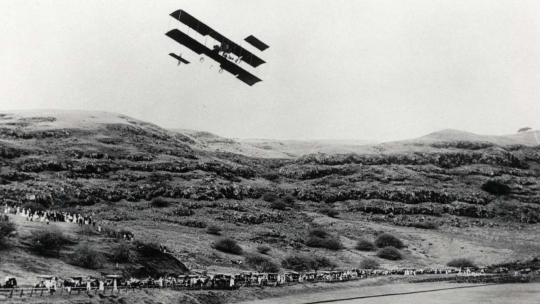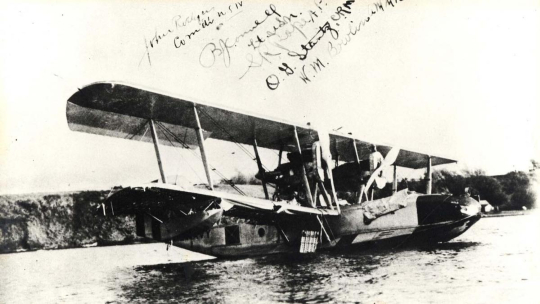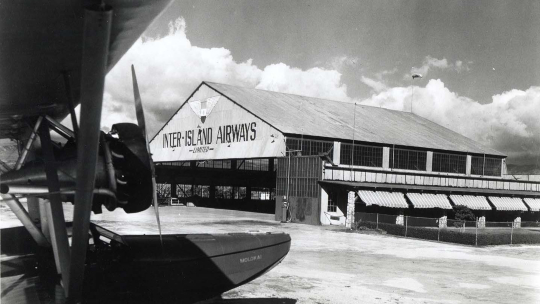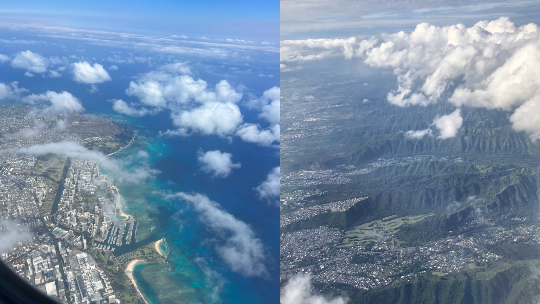When you’re flying from Hawaii to the Mainland, you’re traveling more than 2,500 nautical miles. There’s nothing but sky, ocean, and plane. Pilots may be used to carrying passengers over the Pacific, but it wasn’t always this way. In honor of National Aviation History Month, we’re taking you on a trip back in time. Here’s how Hawaii helped shape commercial and military air travel.
Historic feat
The year was 1910, just seven years after the Wright brothers flew the world’s first powered airplane in North Carolina. More than 3,000 people paid to watch aviator Bud Mars pilot the first flight over Hawaii. The paying spectators gathered at Moanalua polo field, while hundreds more watched from surrounding hilltops. Mars flew 500 feet at 35 miles per hour before landing safely.

Bud Mars flies over Hawaii for the first time. Photo courtesy Hawaii Dept. of Transportation Airports Division
“Technology was at its infancy, so for most people, the flying itself was miraculous and a novelty,” says William Spincola, the senior manager of education programs at Pearl Harbor Aviation Museum.
Four years later, World War I began and brought more changes and innovation. Aircraft became more stable and could fly at higher speeds.
The roaring 20s
The United States Postal Service helped improve commercial aviation in its effort to expand air mail across the continental U.S. By the 1920s, routes were well-established and technology was safer.
But there was still unexplored territory – flying over the Pacific. Navy Commander John Rodgers tried to fly from San Francisco to Honolulu in 1925. But the aircraft ran out of fuel due to unexpected headwinds. It landed several hundred miles from Kauai. The crew converted their plane into a lifeboat and sailed the rest of their way to Hawaii.

The seaplane that flew and then sailed into Hawaii. Photo courtesy HDOT Airports Division
“You’d think it was a failed mission since they didn’t make landfall,” says Spincola. “But they survived; they were so ingenious turning their plane into a boat, it actually went a long way to prove that aviation can achieve these goals and become safer.”
The Army completed the first flight from the Mainland to Hawaii two years later.
Connecting the Islands
Until 1929, people traveled between the Hawaiian Islands by steamboat, schooner, or outrigger canoe. But seas could be rough and the trip took days. A steamship company introduced interisland flying and created Inter-Island Airways (now Hawaiian Airlines).

Inter-Island Airways plane hangar in the 1930s. Photo courtesy HDOT Airports Divison
When flights began, planes could carry just 13 passengers. After the airline secured an airmail contract in the 1930s, it purchased larger planes with better engines and improved safety features to carry both mail and people.
“But passengers were paying a premium since they were taking up valuable space for mail,” says Spincola. “Airlines had to charge them a lot to make it worthwhile to haul a person versus a bag of mail.”
Transpacific flight
The aviation industry’s focus in the 1930s was to fly mail from the U.S. to Asia. Pan American Airways pioneered the first transpacific flight in 1937. The plane took off from California and made multiple refueling stops at islands in the Pacific, including Hawaii, before reaching its destination of Hong Kong.
“Airplanes didn’t have the range like they do today to fly over the ocean nonstop. They had to island hop,” says Spincola.

Pan Am's inaugural commercial fight to Hawaii arrives at Pearl Harbor. Photo courtesy HDOT Airports Division
Once the route was established, Pan Am started carrying passengers as well. It was still an experience reserved for those who were wealthy. Luxurious accommodations included sleeping areas, a lounge, and a dining room.
“Pan Am played up the idea of elegant air travel,” explains Spincola. “It was romantic and exciting for that time.”
By then, navigation technology also improved. Pilots were using radio signals to calculate aircraft position instead of using a process called dead reckoning, which involved information like the aircraft’s last-known position, speed, and wind direction.
“Pan Am set up radio navigation beacons here in Hawaii and along its entire route to the Orient,” says Spincola. “Hawaii ended up becoming a critical hub for transpacific crossings. And Pan Am paved the way for long-range overwater travel. It was safe and efficient; it could fly cargo, mail, and passengers safely and comfortably.”
The jet age and today
The aviation industry boomed in the 1950s because of World War II and the invention of jet engines for the military.
“Airplanes could fly farther, faster, higher, and safer,” says Spincola. “After the war, everyone in our country got comfortable with flying. It was no longer the scary, exotic, daredevil thing people paid money to see.”

Pan Am planes at Honolulu International Airport in 1966. Photo courtesy HDOT Airports Division
Jet engines allowed manufacturers to build larger aircraft to carry more people, which resulted in lower fares. Between 1955 and 1972, passenger numbers nearly quadrupled.
“There was a big cost savings for the airlines because jet airplanes are less expensive to operate than piston engines,” says Spincola. “So the price of seats come way down and the middle class is now starting to fly.
“For the first time, families could take a vacation in Hawaii and it’s no longer an elite thing to do. But it took a lot of work and a lot of effort from heroic people back in the 1920s and 30s to make it what it is today.”

Some beautiful views as you fly into Hawaii today.
SU24F




